10 Seating Terms To Know When Planning An Auditorium
By Jenna Brown
March 11, 2020
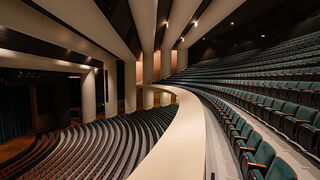
There’s a lot to consider when planning an auditorium, and seating is a big part of that process. When you’re working with your seating provider to determine the right chairs for the space, there’s several terms that are helpful to know in order to understand the experience different seats will offer your patrons.
Below, we’ve compiled ten seating terms and why they’re important dimensions and measurements when selecting seating for your auditorium.
1. Chair Envelope
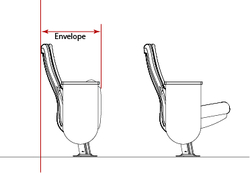
The chair envelope is the front to back dimension of an unoccupied chair. In chairs with self-rising seats, the envelope is measured with the seat in the “up” position, as shown below. Accessories like cupholders can impact this dimension, as the forward location is typically whichever component of the chair extends the most into the row.
2. Clear Passage
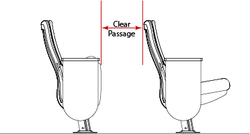
Clear passage is the space between the front of the chair to the back of the chair in front of it. There is a minimum amount of clear passage required by code for safety, and additional clear passage increases patron comfort.
3. Back-To-Back Spacing (Row Spacing)
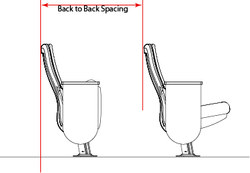
Back-to-back spacing, also called row spacing, is the total space allocated for each row of chairs. It is the distance between the back of a chair to the back of the chair in front of it, and it’s the sum of the chair envelope and clear passage. Typically, this space is three feet (3.0’), but additional space may be necessary depending on accessories, the number of chairs per row, and access to aisles.
4. Back Pitch
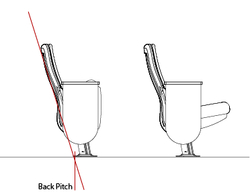
Back pitch is the angle of recline of the back of the chair. The back pitch is measured in degrees from vertical, and generally ranges from 16° to 24° but the purpose of the space or position of the chair can impact the angle. For example, the back pitch would need to be greater than 24° in a planetarium where patrons are looking upwards. On the other hand, the back might be less than 16° for chairs in a high balcony of a performing arts theater.
Generally, the layout engineer will designate the back pitch for each chair section in the layout drawing. The layout engineer will give their accommodations during the layout process and then design row spacing to that accommodation. Since the chair back and standard come separately, the back pitch can be adjusted on site by the installer, if needed.
5. Back Height
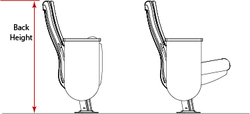
Back height is the height from the floor to the top of the chair back. Traditionally, back height is 32 inches, however backs may be as high as 44 inches, depending on the needs of the space. For seating mounted on treads and risers, the back height is considered a rail by some code authorities.
Back height impacts the overall back-to-back spacing as a higher back requires additional space. Back height also impacts sight lines, as a higher back can obstruct patron view if the chairs aren’t staggered properly.
6. Eye Level
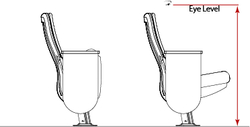
Eye level is the distance from the floor to the eyes of a patron in an occupied seat. This measurement is specified at 44 inches above the level floor, and this is an average identified from ergonomic studies. Eye level is important for developing sight lines to the focal point of the stage or screen.
7. Chair Size
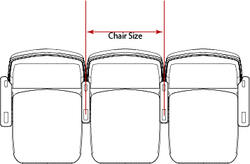
Chair size is the distance from center-of-arm to center-of-arm, which is the full width of the chair. The most common chair sizes range from 19 to 22 inches, but they may be narrower or wider depending on the chair. For example, a stadium chair may be 18 inches in width, but premium chair models, like a cinema recliner, could be up to 26 inches wide. At Irwin Seating, our most popular chairs have sizes between 19 and 24 inches.
Finding the right balance between capacity and comfort is important for the experience patrons have in your space. With your patrons in mind, try to remember that small chair sizes will give your space maximum capacity, but they could negatively affect comfort and will come with their own accessory restrictions. Your chair manufacturer can help you find the right balance and keep you informed with any restrictions you could face.
8. Chair Size Line
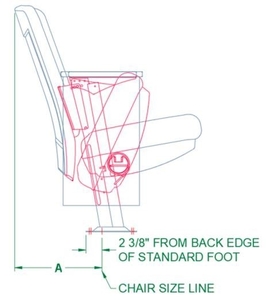
The chair size line is a consistent point on the chair that is used by the draftsperson laying out the space. This point, measured along the run of a row, is then used by installation crews to determine the proper location of that row with in the space. Other chair measurement points can be used in similar ways, the most common being:
- Back edge of standard foot
- Drill holes in the mount
- The seat pivot
The chair size line is also commonly used to measure row spacing, clearances, clear spaces, and other dimensions within the layout. Look for these dimensions as they can indicate some key information about your project. For Irwin Seating, this dimensions can be located on the right hand side of the drawing and are clearly labeled.
9. Back Or Chair Overhang
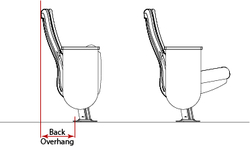
Back overhang, also referred to as chair overhang, is the distance a chair extends back from the chair size line. Back overhang is critical for eliminating interference with obstructions like risers, walls, support columns, or railings. When utilized properly, back overhang eliminates hazardous gaps behind rows of chairs installed on risers.
10. Row Length
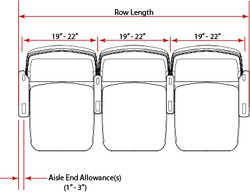
Row length is the sum of the chair sizes plus an additional 2 - 6 inches of aisle end allowances. Accessories like cup holders on the armrests can add to this dimension.
Row length is closely tied to clear passage in building code. The more chairs per row, and therefore the greater row length, the more clear passage that is required.
Closing Thoughts
The most important thing to know about the space you’re designing is its intended purpose. The purpose of the space plays a big role in the experience patrons will expect, and therefore an important aspect when determining seating choices and layout. One aspect of designing a space to match the patron experience is gaining a full understanding of the chairs filling the space. The layout engineers at your seat manufacturer are ready to answer all your questions about our chairs to make sure you have the right chair and layout for your space.